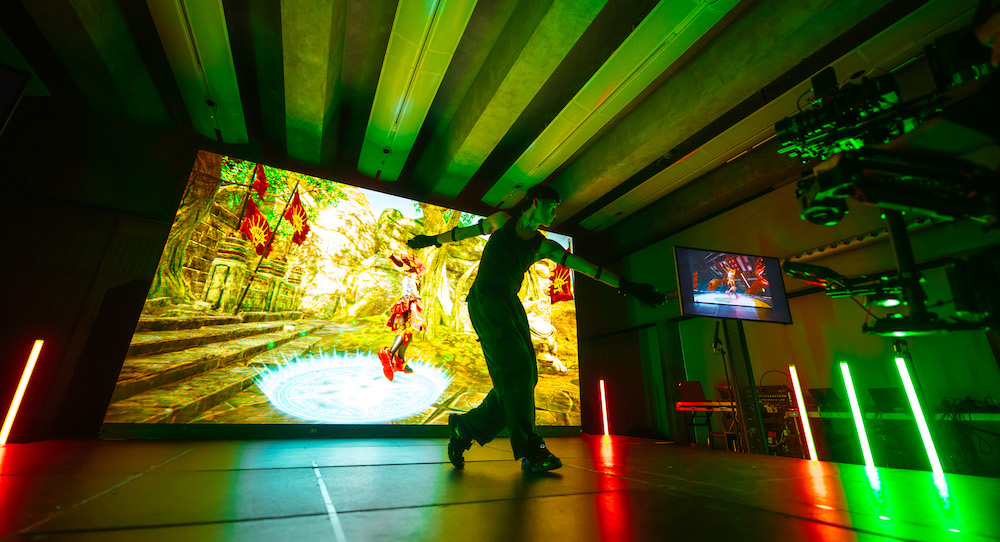Sydney Opera House, Sydney.
Friday 7 October.
Lu Yang is a multidisciplinary artist whose body of work looks at contemporary issues through a variety of lenses such as biology, psychology and Buddhism. The main character and focus in Yang’s work, DOKU, The Binary World, is the ongoing development of the avatar creation Doku – Dokusho Dokushi — “We are born alone, we die alone” — that he has collaborated with a large global team from various digital and creative studios, including movement and sound artists, to develop a world of videos where DOKU features.
DOKU has a growing body of work in videos and performances, using live suit motion capture technology, amongst a myriad of mediums. DOKU explores various worlds with detailed manga inspired graphics, in places such as New York. Yang’s work with DOKU has been in progress for many years, this particular stream of work commencing in 2018. With each performance new areas of the technology are explored, such as the addition of facial tracking, the ability to destroy buildings, and the widening variation of camera views, through a manga lens. DOKU has Yang’s face, with the addition of facial expression from the movement artists he has collaborated with, and an asexual body.
Yang’s work does not focus on pop culture; rather, it explores his own inner world, dreams and the state of the environment. DOKU, The Binary World explores the six realms of Buddhist reincarnation, commencing with heaven, and ending in hell. DOKU, The Binary World goes through the realms, with a meeting of heaven and hell, each scene introducing a renewed version of the avatar, and a merging of the two heaven and hell avatars at the end. There were hints of environmental issues even in this religion focused work.
DOKU, The Binary World had its world premiere this October, Co-presented by Sydney Opera House and Freespace – West Kowloon Cultural District Hong Kong, and co-produced by MetaObjects and Exhibitionist. The breakthrough element in this work being live performance, real-time motion capture, with simultaneous performances in two cities on differing continents. The two performers alternated being on stage/screen, between the different scenes of the six realms.
The background for each scene was quite detailed, and it was amazing how the scene kept morphing as the view changed and created an almost 3-D effect. This manga-esque view of the city was at times almost dizzying in the travel pathway it took us on.
Choreographically, the movement was not so breakthrough, particularly when juxtaposed with the wonderous scenic world created by Yang, and detailed use of the motion capture technology. This technology is wonderful; it gives us so much room for exploration, particularly in the choreographic department. Motion capture is not new, though, and it has been used by professional choreographers for years to make fantastic movement work that the technology compliments and strengthens. This work of Yang’s seemed to wholly lean on the technology to wow the audience, with movement as an afterthought. There did not seem to be any thought given to creativity in the movement dialogue between the two artists, that leant itself to having any kind of relationship, particularly with the chance to merge their work on a screen and make it really something fantastic. There did not carry across the impression that there was any real reason for having the two movement artists in two differing locations, aside from perhaps a nod at the last few years in pandemic. How communication in the world has become more and more screen-based, which opens up the world to anyone with a device. These two movers (Sydney – Taiga Kita-Leong, Hong Kong – Kenny Leung) are of a professional performance background, and it would have been wonderful for their ability and performing qualities to fully merge with the opportunity DOKU, The Binary World could have afforded them. This afterthought to their ability to expand the piece beyond a showcase of technology was a great letdown to the work of Yang and collaborators.
The avatar Doku is entirely interesting, having come thus far with a growing portfolio of work that now expands beyond the screen. It will be interesting to see if development continues to envelop and enhance the mediums the team collaborates with, so as to create something new, something beyond what has already been done. Yang certainly has the mind to continue to grow with the work, expanding themes that resonate with him, and we look forward to seeing what the future holds for Doku.
By Linda Badger of Dance Informa.

















